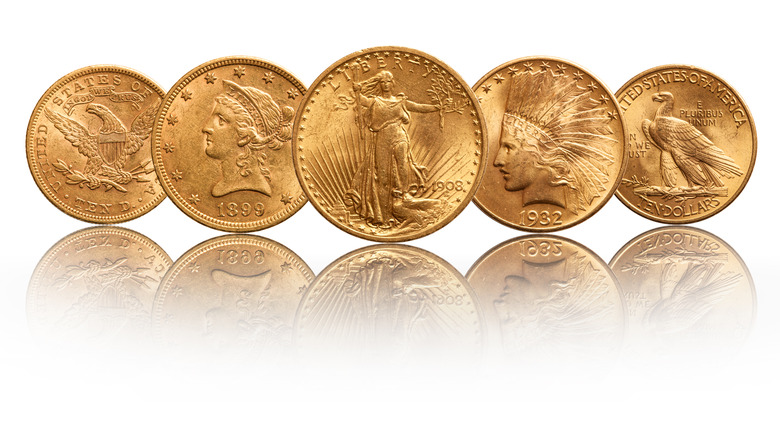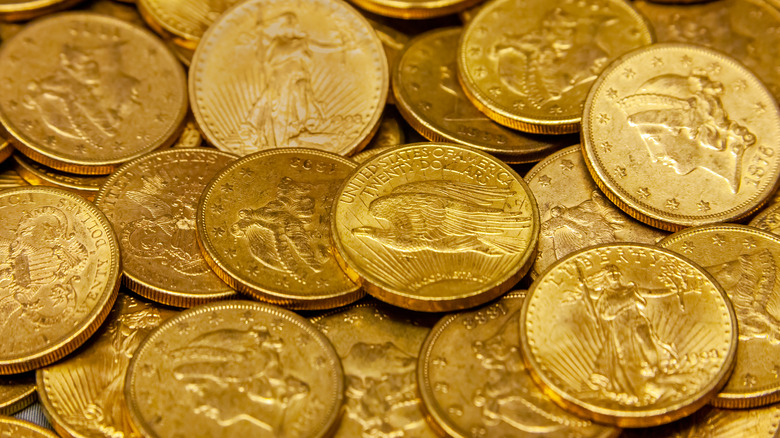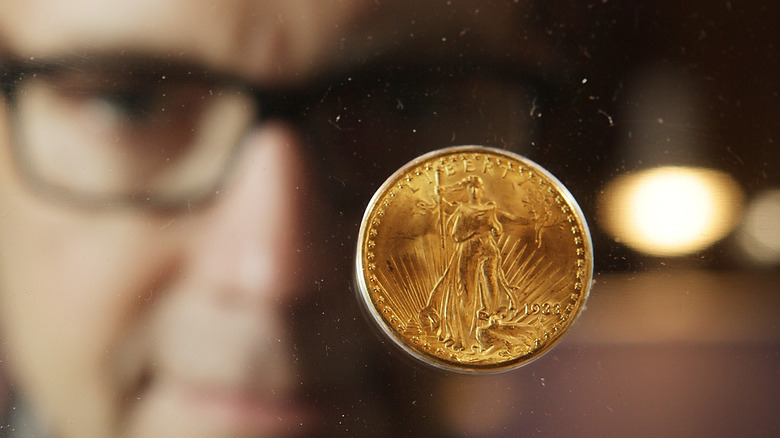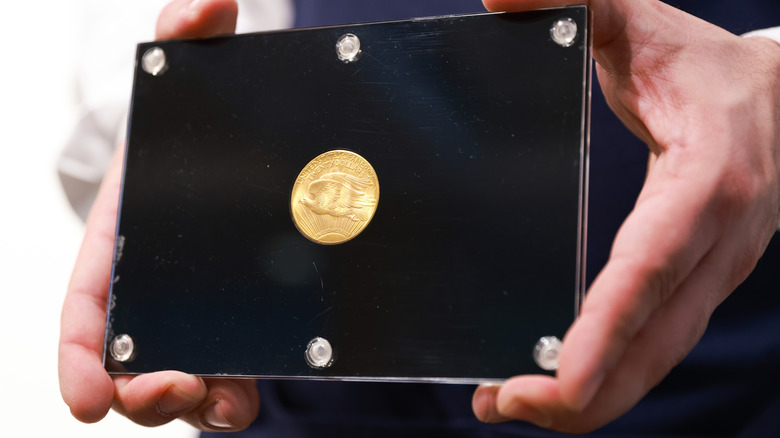Why The US Stopped Making The $20 Coin
For all the talk in recent years about a coming cashless society, there is something satisfying about the rustle of paper money or the jingling of coins. Still, even for those who like cash, there are some units of currency that outlive their time. Since 2006, pennies and nickels cost more to make than they're worth (per CNN Business), prompting ongoing debate about the value of minting them.
And, strange though it may seem, currency can fall victim to fashion and popularity as well as practicality. Dollar coins, though more expensive than bills, last much longer, and many nations have done away with the equivalent of dollar bills in favor of the coins. But, per The Kansas City Star, Americans just don't want to change paper for metal, despite concerted efforts by the government to sell them on the idea.
It's not the first time the United States has rejected a coin for its paper counterpart. The country used to have a gold $20 coin, more than one in fact. There were three types issued of the first such coin, the Liberty Head (per Rare Coin Wholesalers), with a successor Saint-Gaudens double eagle coin following (per Liberty Coin Service). But it seems Americans of the late 19th and early 20th centuries favored paper money just as much as their descendants; Liberty Coin Service says that the gold dollars couldn't displace the $20 bill, and the Liberty Heads hardly circulated before being retired. According to the U.S. Mint, the currency was retired altogether in 1933, a victim of financial reform.
The $20 coin was born of the Gold Rush
The original $20 coin, the Liberty Head, was first minted after the California Gold Rush began delivering its wealth to the Philadelphia Mint. Per Rare Coin Wholesalers, the new riches were initially used for $2.50 pieces, but it soon became apparent that there was too much gold to use on such a small coin — in value and in size. New legislation in 1849 authorized a tiny gold dollar and a large $20 coin, which began circulating in 1850. The design of the latter, briefly complicated by an outlandish corruption scheme at the mint, featured the head of a woman representing liberty on one side and an eagle with spread wings, a shield on its chest, and 13 stars on the other.
This coin, the Type I Liberty Head, was minted from 1850 to 1866. By then, the Civil War had ravaged the United States, and in its aftermath, divisions in the country remained so raw that the 1865 Mint Act ordered "In God We Trust" put on all coins as part of an appeal for guidance. This was added to the $20 coin through minor adjustments to the eagle and its stars on the backside. These Type II Liberty Heads were minted until 1877 and saw more use abroad than at home.
The Type III Liberty Head adjusted Lady Liberty's head placement and tweaked the wording of the denomination. The largest mint of the three, it lasted until 1907. But besides falling in popularity to the $20 bill, it faced another challenge — a president's displeasure.
The Roosevelts remade, then ended, the $20 coin
Playing to the media has become a much bigger part of politicians' work than it was at the turn of the century, but few today can do so with the flair of Theodore Roosevelt. He turned his outsized charisma toward promoting many things — the Square Deal, national parks, himself — and he wanted the United States to project a glorious image. According to the U.S. Mint, Roosevelt found the coins of early 20th-century America unattractive and unworthy of the triumph the country's democracy had achieved in the world. It was on his personal invitation that noted artist Augustus Saint-Gaudens redesigned the U.S. coinage. His new $20, which was first struck in 1907, is widely considered the most beautiful coin ever made for U.S. currency. It featured a full figure of Lady Liberty bearing a torch and an olive branch and surrounded by stars on one side, with an eagle soaring before a sunrise on the other.
But as one Roosevelt engineered a radical new design for the $20, another would see the coin retired altogether. Per the Federal Reserve History, as part of his efforts to combat the banking crisis of 1933, Franklin Delano Roosevelt reshaped U.S. policy regarding gold through a series of controversial measures. Among these were discontinuing production of gold coins (per the U.S. Mint) and a gold recall, which saw many of the nation's gold coins melted down (per Rare Coin Wholesalers). Not that the average American would have seen a sudden decline in $20 coins; since 1929, they had been rarely circulated and were primarily used to feed the gold reserve anyway.
The 1933 $20 was the coin that got away
Per Rare Coin Wholesalers, nearly 500,000 $20 coins were minted by the United States government in 1933 before Franklin Roosevelt's recall came into effect. Most were consigned to the melting pot, with exceptions made for two coins given over to the Smithsonian in 1934. For any that escaped the fire, the official stance of the government was and remains that this mintage was never circulated, making possession of these coins illegal.
And yet, in 1944 (per the U.S. Mint), it was discovered that 10 of the 1933 $20 coins were on the loose, one of them having even been given formal clearance to leave the U.S. and enter the personal coin collection of King Farouk of Egypt. The nine coins still on U.S. soil were seized or surrendered, but the Farouk coin remained in his hands until his deposition. It, along with many of his other valuables, were put up for auction by the Republic of Egypt in 1954. The U.S. government asked that the Farouk coin be taken off the market, and the new Egyptian government complied, but the whereabouts of the coin afterwards was long a mystery.
When the U.S. government put a surviving 1933 $20 coin up for auction itself in 2002, it was widely assumed that it was the same Farouk coin. It had been seized from an attempted illegal sale at the Waldorf-Astoria in 1996. Special arrangements were made to let it be sold into private hands and, per the Chicago Tribune, it sold for nearly $7.6 million.



